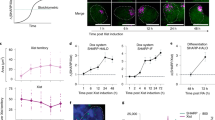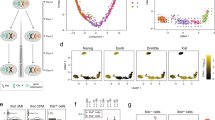Abstract
One X chromosome, selected at random, is silenced in each female mammalian cell. Xist encodes a noncoding RNA that influences the probability that the cis-linked X chromosome will be silenced. We found that the A-repeat, a highly conserved element within Xist, is required for the accumulation of spliced Xist RNA. In addition, the A-repeat is necessary for X-inactivation to occur randomly. In combination, our data suggest that normal Xist RNA processing is important in the regulation of random X-inactivation. We propose that modulation of Xist RNA processing may be part of the stochastic process that determines which X chromosome will be inactivated.
This is a preview of subscription content, access via your institution
Access options
Subscribe to this journal
Receive 12 print issues and online access
$189.00 per year
only $15.75 per issue
Buy this article
- Purchase on Springer Link
- Instant access to full article PDF
Prices may be subject to local taxes which are calculated during checkout






Similar content being viewed by others
References
Lyon, M.F. Gene action in the X-chromosome of the mouse (Mus musculus L). Nature 190, 372–373 (1961).
Martin, G.R. et al. X-chromosome inactivation during differentiation of female teratocarcinoma stem cells in vitro. Nature 271, 329–333 (1978).
Avner, P. & Heard, E. X-chromosome inactivation: counting, choice and initiation. Nat. Rev. Genet. 2, 59–67 (2001).
Marahrens, Y., Loring, J. & Jaenisch, R. Role of the Xist gene in X chromosome choosing. Cell 92, 657–664 (1998).
Gribnau, J., Luikenhuis, S., Hochedlinger, K., Monkhorst, K. & Jaenisch, R. X chromosome choice occurs independently of asynchronous replication timing. J. Cell Biol. 168, 365–373 (2005).
Lee, J.T., Davidow, L.S. & Warshawsky, D. Tsix, a gene antisense to Xist at the X-inactivation centre. Nat. Genet. 21, 400–404 (1999).
Luikenhuis, S., Wutz, A. & Jaenisch, R. Antisense transcription through the Xist locus mediates Tsix function in embryonic stem cells. Mol. Cell. Biol. 21, 8512–8520 (2001).
Wutz, A. & Jaenisch, R. A shift from reversible to irreversible X inactivation is triggered during ES cell differentiation. Mol. Cell 5, 695–705 (2000).
Panning, B. & Jaenisch, R. DNA hypomethylation can activate Xist expression and silence X-linked genes. Genes Dev. 10, 1991–2002 (1996).
Sheardown, S.A. et al. Stabilization of Xist RNA mediates initiation of X chromosome inactivation. Cell 91, 99–107 (1997).
Wutz, A., Rasmussen, T.P. & Jaenisch, R. Chromosomal silencing and localization are mediated by different domains of Xist RNA. Nat. Genet. 30, 167–174 (2002).
Hoki, Y. et al. A proximal conserved repeat in the Xist gene is essential as a genomic element for X-inactivation in mouse. Development 136, 139–146 (2009).
Cattanach, B.M. & Rasberry, C. Identification of the Mus castaneus Xce allele. Mouse Genome 92, 114–115 (1994).
Panning, B., Dausman, J. & Jaenisch, R. X chromosome inactivation is mediated by Xist RNA stabilization. Cell 90, 907–916 (1997).
Mlynarczyk-Evans, S. et al. X chromosomes alternate between two states prior to random X-inactivation. PLoS Biol. 4, e159 (2006).
Lee, J.T. & Lu, N. Targeted mutagenesis of Tsix leads to nonrandom X inactivation. Cell 99, 47–57 (1999).
Sun, B.K., Deaton, A.M. & Lee, J.T. A transient heterochromatic state in Xist preempts X inactivation choice without RNA stabilization. Mol. Cell 21, 617–628 (2006).
Norris, D.P. et al. Evidence that random and imprinted Xist expression is controlled by preemptive methylation. Cell 77, 41–51 (1994).
Brockdorff, N. et al. Conservation of position and exclusive expression of mouse Xist from the inactive X chromosome. Nature 351, 329–331 (1991).
Brown, C.J. et al. The human XIST gene: analysis of a 17 kb inactive X-specific RNA that contains conserved repeats and is highly localized within the nucleus. Cell 71, 527–542 (1992).
Perocchi, F., Xu, Z., Clauder-Munster, S. & Steinmetz, L.M. Antisense artifacts in transcriptome microarray experiments are resolved by actinomycin D. Nucleic Acids Res. 35, e128 (2007).
Lin, S., Xiao, R., Sun, P., Xu, X. & Fu, X.D. Dephosphorylation-dependent sorting of SR splicing factors during mRNP maturation. Mol. Cell 20, 413–425 (2005).
Fazzio, T. & Panning, B. Condensin complexes regulate mitotic progression and interphase chromatin structure in embryonic stem cells. J. Cell Biol. 188, 491–503 (2010).
Mathews, D.H., Sabina, J., Zuker, M. & Turner, D.H. Expanded sequence dependence of thermodynamic parameters improves prediction of RNA secondary structure. J. Mol. Biol. 288, 911–940 (1999).
Zuker, M. & Jacobson, A.B. “Well-determined” regions in RNA secondary structure prediction: analysis of small subunit ribosomal RNA. Nucleic Acids Res. 23, 2791–2798 (1995).
Cartegni, L., Wang, J., Zhu, Z., Zhang, M.Q. & Krainer, A.R. ESEfinder: A web resource to identify exonic splicing enhancers. Nucleic Acids Res. 31, 3568–3571 (2003).
Zhao, J., Sun, B.K., Erwin, J.A., Song, J.J. & Lee, J.T. Polycomb proteins targeted by a short repeat RNA to the mouse X chromosome. Science 322, 750–756 (2008).
Maenner, S. et al. 2-D structure of the A region of Xist RNA and its implication for PRC2 association. PLoS Biol. 8, e1000276 (2010).
Marahrens, Y., Panning, B., Dausman, J., Strauss, W. & Jaenisch, R. Xist-deficient mice are defective in dosage compensation but not spermatogenesis. Genes Dev. 11, 156–166 (1997).
Sado, T., Hoki, Y. & Sasaki, H. Tsix silences Xist through modification of chromatin structure. Dev. Cell 9, 159–165 (2005).
Csankovszki, G., Panning, B., Bates, B., Pehrson, J.R. & Jaenisch, R. Conditional deletion of Xist disrupts histone macroH2A localization but not maintenance of X inactivation. Nat. Genet. 22, 323–324 (1999).
Heard, E. et al. Methylation of histone H3 at Lys-9 is an early mark on the X chromosome during X inactivation. Cell 107, 727–738 (2001).
Rougeulle, C. et al. Differential histone H3 Lys-9 and Lys-27 methylation profiles on the X chromosome. Mol. Cell. Biol. 24, 5475–5484 (2004).
Cartegni, L., Chew, S.L. & Krainer, A.R. Listening to silence and understanding nonsense: exonic mutations that affect splicing. Nat. Rev. Genet. 3, 285–298 (2002).
Herzing, L.B., Romer, J.T., Horn, J.M. & Ashworth, A. Xist has properties of the X-chromosome inactivation centre. Nature [see comments] 386, 272–275 (1997).
Lee, J.T., Lu, N. & Han, Y. Genetic analysis of the mouse X inactivation center defines an 80-kb multifunction domain. Proc. Natl. Acad. Sci. USA 96, 3836–3841 (1999).
Monkhorst, K., Jonkers, I., Rentmeester, E., Grosveld, F. & Gribnau, J. X inactivation counting and choice is a stochastic process: evidence for involvement of an X-linked activator. Cell 132, 410–421 (2008).
Nesterova, T.B. et al. Skewing X chromosome choice by modulating sense transcription across the Xist locus. Genes Dev. 17, 2177–2190 (2003).
Nesterova, T.B. et al. Dicer regulates Xist promoter methylation in ES cells indirectly through transcriptional control of Dnmt3a. Epigenetics Chromatin 1, 2 (2008).
Sado, T., Hoki, Y. & Sasaki, H. Tsix defective in splicing is competent to establish Xist silencing. Development 133, 4925–4931 (2006).
Shibata, S. & Lee, J.T. Characterization and quantitation of differential Tsix transcripts: implications for Tsix function. Hum. Mol. Genet. 12, 125–136 (2003).
Wutz, A. & Gribnau, J. X inactivation Xplained. Curr. Opin. Genet. Dev. 17, 387–393 (2007).
Lee, J.T. Homozygous Tsix mutant mice reveal a sex-ratio distortion and revert to random X-inactivation. Nat. Genet. 32, 195–200 (2002).
Blewitt, M.E. et al. SmcHD1, containing a structural-maintenance-of-chromosomes hinge domain, has a critical role in X inactivation. Nat. Genet. 40, 663–669 (2008).
Fazzio, T.G., Huff, J.T. & Panning, B. An RNAi screen of chromatin proteins identifies Tip60-p400 as a regulator of embryonic stem cell identity. Cell 134, 162–174 (2008).
Cohen, H.R. & Panning, B. XIST RNA exhibits nuclear retention and exhibits reduced association with the export factor TAP/NXF1. Chromosoma 116, 373–383 (2007).
Plath, K. et al. Role of histone H3 lysine 27 methylation in X inactivation. Science 300, 131–135 (2003).
Huang, Y., Yario, T.A. & Steitz, J.A. A molecular link between SR protein dephosphorylation and mRNA export. Proc. Natl. Acad. Sci. USA 101, 9666–9670 (2004).
Nusinow, D.A. et al. The histone domain of macroH2A1 contains several dispersed elements that are each sufficient to direct enrichment on the inactive X chromosome. J. Mol. Biol. 371, 11–18 (2007).
Acknowledgements
We thank K. Worringer, J. Huff, T. Fazzio, M.K. Alexander, L. Spector, P. O'Farrell and I. Listerman for critical reading of the manuscript, X.-D. Fu and S. Lin (University of California, San Diego) for tet-repressible ASF/SF2 cells, N. Krogan for mass spectrometry and A. Krainer (Cold Spring Harbor) for ASF/SF2 antibodies. This work was funded in part by US National Institutes of Health grant R01 GM088506.
Author information
Authors and Affiliations
Contributions
M.E.R.-T., A.A.A., H.R.K., D.J.T. and B.P. designed and performed experiments and wrote the manuscript, and A.W., I.D.T. and G.F.K. provided cell lines.
Corresponding author
Ethics declarations
Competing interests
The authors declare no competing financial interests.
Supplementary information
Supplementary Text and Figures
Supplementary Figures 1-5 and Supplementary Table 1 (PDF 1421 kb)
Rights and permissions
About this article
Cite this article
Royce-Tolland, M., Andersen, A., Koyfman, H. et al. The A-repeat links ASF/SF2-dependent Xist RNA processing with random choice during X inactivation. Nat Struct Mol Biol 17, 948–954 (2010). https://doi.org/10.1038/nsmb.1877
Received:
Accepted:
Published:
Issue Date:
DOI: https://doi.org/10.1038/nsmb.1877
This article is cited by
-
Unraveling the role of Xist in X chromosome inactivation: insights from rabbit model and deletion analysis of exons and repeat A
Cellular and Molecular Life Sciences (2024)
-
Lnc-HZ05 regulates BPDE-inhibited human trophoblast cell proliferation and affects the occurrence of miscarriage by directly binding with miR-hz05
Cell Biology and Toxicology (2022)
-
BAF complex-mediated chromatin relaxation is required for establishment of X chromosome inactivation
Nature Communications (2022)
-
Novel lnc-HZ03 and miR-hz03 promote BPDE-induced human trophoblastic cell apoptosis and induce miscarriage by upregulating p53/SAT1 pathway
Cell Biology and Toxicology (2021)
-
Deletion of the XIST promoter from the human inactive X chromosome compromises polycomb heterochromatin maintenance
Chromosoma (2021)



